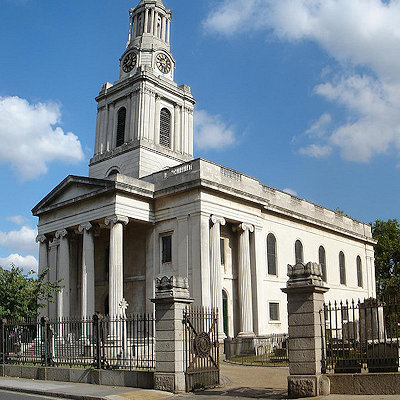
Like us on Facebook
PLACE NAMES


 
|
|
Poplar
|

|
|
|
Poplar is an historical, mainly residential area of East London, England, in the London Borough of Tower Hamlets. It is about 5.5 miles (8.9 km) east of Charing Cross. Historically a hamlet in the parish of Stepney, Middlesex, in 1817 Poplar became a civil parish.
In 1855 the Poplar District of the Metropolis was formed, which also included Bromley and Bow. The district became the Metropolitan Borough of Poplar in 1900 which was abolished in 1965. The district centre is Chrisp Street Market. Poplar contains notable examples of public housing including the Lansbury Estate and Balfron Tower.
Architecturally, it is a mixture of 18th and 19th-century terraced houses and 20th-century council estates.
A new Church Green was created in 2012 on the site of the former Blitz-bombed Catholic church, across the road from the current church designed by Adrian Gilbert Scott. It is open to the public during the day and public sculptures include:
- The former Catholic Boys' School entrance statue dedicated to dockers and seafarers.
- A 15-foot crucifix that stood on the site of the old high altar.
- A contemporary granite and light sculpture, A Doorway of Hope, by sculptor Nicolas Moreton.
- St Matthias Old Church.
Poplar is at the northern end of the Blackwall Tunnel. A tunnel in the Blackwall area was originally proposed in the 1880s. According to Robert Webster, then MP for St Pancras East, a tunnel would "be very useful to the East End of London, a district representing in trade and commerce a population greater than the combined populations of Liverpool, Manchester and Birmingham." By this time, all road bridges in London east of the ferry at Chiswick were toll-free, but these were of little use to the two fifths of London's population that lived to the east of London Bridge. The Thames Tunnel (Blackwall) Act was created in August 1887, which provided the legal framework necessary to construct the tunnel. The initial proposal, made by Sir Joseph Bazalgette, called for three parallel tunnels, two for vehicular traffic and one for foot, with an expected completion date of works within seven years. It was originally commissioned by the Metropolitan Board of Works but, just before the contract was due to start, responsibility passed to the London County Council (LCC) when the former body was abolished in 1889 and Bazalgette's work on the tunnel ended.
The original tunnel as built was designed by Sir Alexander Binnie and built by S. Pearson & Sons, between 1892 and 1897, for whom Ernest William Moir was its lead engineer. It was constructed using tunnelling shield and compressed air techniques and a Greathead shield (named after its inventor, James Henry Greathead). It was lit by three rows of incandescent street lights. To clear the site in Greenwich, more than 600 people had to be rehoused, and a house reputedly once owned by Sir Walter Raleigh had to be demolished. The tunnel was officially opened by the Prince of Wales on 22 May 1897. 800 men were employed in its construction, during which seven deaths were recorded.
Today the western bore is only used for northbound traffic and is not accessible to vehicles taller than 4 m (13 ft). The tunnel itself has several sharp bends, whose purpose was to prevent horses from bolting once they saw daylight. The tunnel carries two lanes of traffic, though higher vehicles need to keep to the left-hand lane so that they do not hit the tunnel's inner lining.
Due to the increase in motor traffic in the early 20th century, the capacity of the original tunnel was soon perceived as inadequate. In 1930, John Mills, MP for Dartford, remarked that HGVs delivering from Essex to Kent could not practically use any crossing of the Thames downstream of the tunnel. The LCC obtained an act to construct a new tunnel in 1938, but work did not start due to the outbreak of World War II. Construction eventually started in 1958 with preliminary work on the northern approach road. By this time, traffic had become progressively worse. In 1960, Richard Marsh, MP for Greenwich complained that vehicles could spend 30 to 45 minutes stuck in tunnel traffic.
The new eastern tunnel, 8.59 metres (28 ft 2 in) in diameter, was accepted into the roads programme in March 1959, and construction started in March 1960. It was opened on 2 August 1967 by Desmond Plummer, Leader of the Greater London Council (GLC). It was wider and usable by vehicles up to 4.72 m (15.5 ft). During construction, transport minister Ernest Marples clarified that unlike the Dartford Tunnel, also then under construction, tolls would not be imposed as the tunnel was already an established route. At the time of opening, the strip lighting in the tunnel was commended as "a big improvement" on the standard provided in the original tunnel. In contrast with the Victorian northbound tunnel, the eastern tunnel had no sharp bends, and emergency telephones were provided. Its distinctive ventilation towers were designed in 1964 by GLC architect Terry Farrell.
In the late 1960s, proposals were made to connect the tunnel with a free-flow, grade-separated motorway system as part of the London Ringways project. Aside from the construction of the A102(M) Blackwall Tunnel approach roads, opened in 1973, these plans were abandoned.
The entrance gateway to the northbound tunnel was Grade II listed in 1973, while the ventilation towers were listed in 2000. In April 1986, the tunnel became part of the UK trunk road network. It was detrunked and control handed to TfL in September 1999.
|
 Feel free to Email me any additions or corrections Feel free to Email me any additions or corrections
LINKS AVAILABLE TO YOUR SITE
| |





